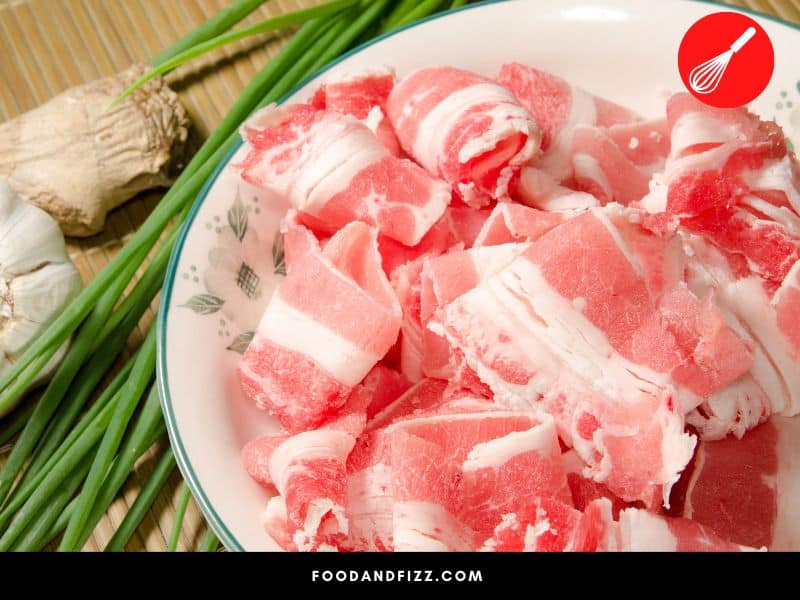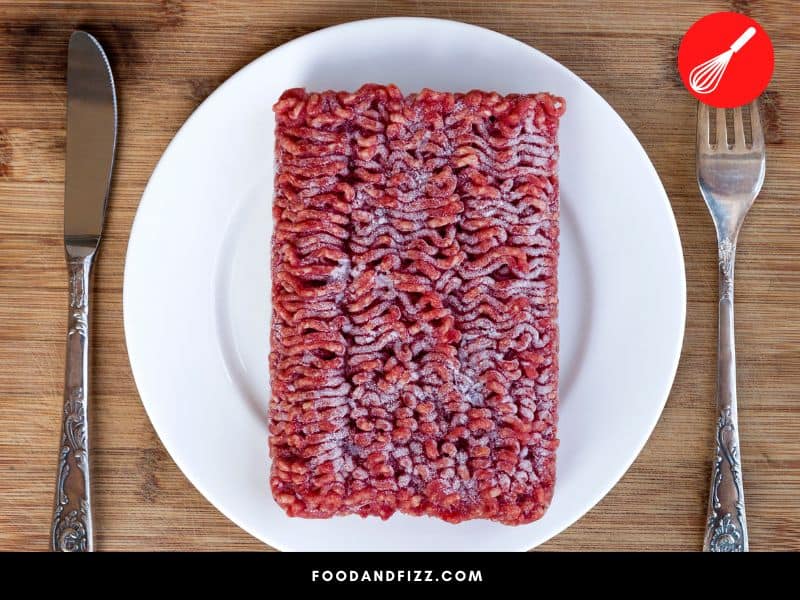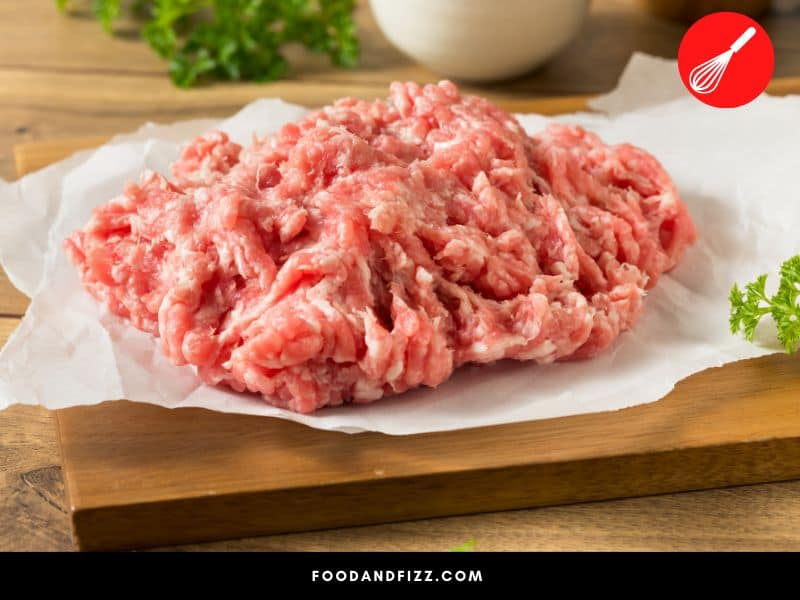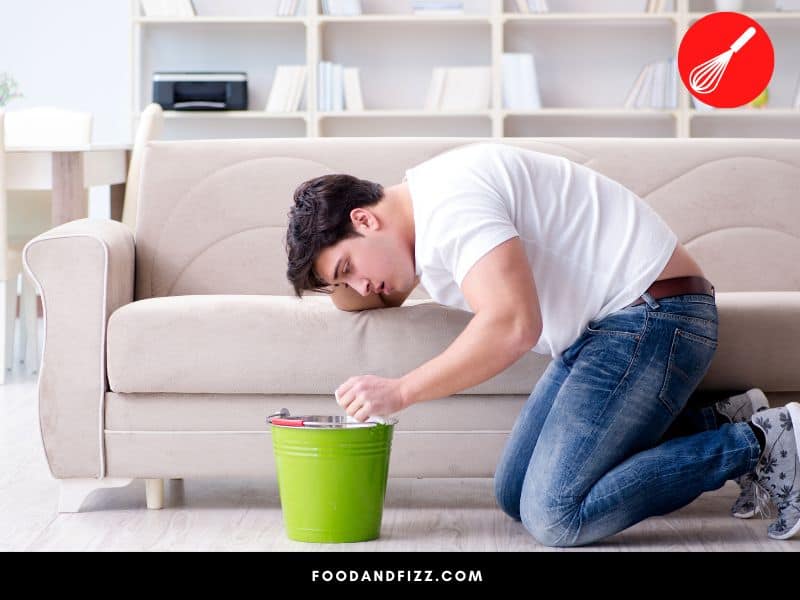Ground beef that is fresh will typically be red or pink in color. Any other colors in the ground beef can lead us to think that something is wrong and that our meat has spoiled.
That wouldn’t totally be inaccurate but there are times when the change in color isn’t due to food spoilage, but due to innate characteristics of the meat or the way it was stored.
This is specifically the case with white spots in ground beef. So what are those white spots, what causes them, and in what scenarios are they harmless to eat?
What are The White Spots in Ground Beef?
White spots in ground beef can sometimes appear when the meat is fatty and the fat has solidified when the ground meat has been frozen and thawed, or when the meat has discolored and has gone bad. If it is due to fat or freezer storage, it is safe to eat. But if it is due to food spoilage, the ground beef must be thrown away.

What Causes White Spots in Ground Beef?
There’s nothing more disappointing than when you’re getting ready to cook your dish and find that your main ingredient is not good to go.
You carefully prepared all your ingredients, only to find that the main star of the show, the ground beef, has white spots. So what do you do?
Luckily, white spots aren’t always unsafe to eat, although if you see them on your ground beef, it’s always a good idea to proceed with caution.
Below, we’ll list the possible reasons for the white spots in your ground beef.
It Could Be Beef Fat
Ground beef can be made from different beef parts and if that part happens to be a fatty part, it is possible that the white spots you see are fat. Especially if your ground beef was stored in the fridge or the freezer, these white spots of fat can be more obvious as fat solidifies and turns whiter in colder temperatures.
If the spots you see are fat from the beef, then it is safe to eat. When you heat up the beef as it is added to your recipe, the fat will melt away and the white spots will disappear.
If you do not want fatty beef, you can opt to get leaner ground beef, although it must be mentioned that especially if you are making burgers out of your ground beef, some fat is necessary not only to get the best flavor and juiciness but also so that your burger will hold together and not crumble, which usually happens with leaner cuts.

Freezer Burn or A Result of Improper Storage
If it isn’t beef fat, the white stuff you see could also be color changes resulting from freezer burn, or from freezing and then thawing the ground beef.
Freezing is one of the most effective ways to preserve food and extend its shelf life. However, freezing can also change the texture and quality of the food, especially if it has been frozen for a long time.
The changes will not be due to food spoilage-causing bacteria, which lie dormant at those low temperatures, but rather due to the physical changes that happen to the food due to the change in temperatures.
Freezer burn is a term that pertains to moisture loss when food is stored in the freezer. To put the whole process in easy-to-understand terms, it is what happens when the frozen water molecules are able to escape the food, due to inadequate wrapping or due to prolonged storage, resulting in dry and dehydrated food.
Not storing in airtight containers allows these water molecules to escape, and consequently allows oxygen to creep in. When oxygen is able to come in, oxidation can happen. Oxidation can severely deteriorate the quality and flavor of food and can cause a dulling in its color.
Moisture loss due to freezer burn combined with oxidation can manifest as white spots on your ground beef.
If your ground beef has been frozen, this may likely be the culprit.
It Has Started To Spoil
Unfortunately, this is also possible. While not always the case, it is possible that the white spots on your package of ground beef are caused by food spoilage-causing bacteria, and that your ground beef is no longer safe to eat.
When meat spoils, it undergoes changes that we can readily see, smell and touch. If your ground beef has white spots and other kinds of discoloration or if it has an off-smell or odor and it feels sticky or slimy to the touch, then your ground beef has gone bad and should be discarded right away.
If it is not fat and your ground beef has never been frozen and thawed, it is most likely due to the third reason, in which case you are better off just discarding it rather than risk getting sick.
If you are in any way unsure, I would also recommend just tossing it as the risk of getting sick is far greater than the benefits.
Are White Spots In Ground Beef Safe to Eat?
If the white spots in your ground beef are due to fat in the beef or due to freezer burn, it will be safe for you to eat. In the case of freezer burn, there may be some texture and flavor changes, but as long as the meat does not exhibit any other signs that it is going bad, then you can go ahead and use it in your recipes.
If you are unsure as to the cause of the white spots, and if there are other signs pointing to spoilage, then toss the ground beef and just get a fresh batch. It is never worth risking your health for something like this.
How Do I Prevent White Spots in Ground Beef?
To prevent white spots in your ground beef, we have the following tips.
- Make sure to only source from reputable sources to ensure your ground beef is always safe and properly handled
- Choose a leaner type of ground beef if you do not want it to be too fatty, and thus will have fewer white spots
- Always store your ground beef in airtight, raw meat-dedicated containers to prevent cross-contamination.
- When freezing ground beef make sure it is properly wrapped in cling wrap or stored in freezer-safe bags or airtight containers to minimize freezer burn
- Always refrigerate ground beef and never leave it at room temperature for more than two hours
- Whenever possible, buy ground beef as close to the time you are cooking it to ensure it is fresh
- If you are not cooking it within 1-2 days, store it in the freezer to keep it safe for consumption
Make sure you always properly handle and store your raw meat to ensure the best flavor and best quality, and to ensure that you are not risking your health and your loved ones’ health.

How Do I Know If The Ground Beef I Have Is Still Okay To Use?
Even if your ground beef does not have any white spots, it is useful to know how you can tell if you can still use them in your recipes.
With meat, it is usually pretty easy to tell if it is still safe to eat as meat that is going bad or has gone bad will have obvious color and appearance changes, smell changes, and texture changes.
Here are the things you should look at:
Appearance
White spots may be an indication of food spoilage but it is not always the case. However, if you see fuzzy growths, green or blue mold, or any other unusual color on your ground beef, that is a telltale sign that it has gone bad and should be discarded.
Fresh ground beef will have a rosy pink color or even purplish red. As it is exposed to oxygen, this color will slowly oxidize and turn to a dull brown. Browning ground beef isn’t necessarily bad but it does mean that it has oxidized and is likely on the way to spoiling even if it isn’t there yet.
If your ground beef is somewhere in this brown phase, check for other signs of food spoilage to be sure. If there are no other signs, it is safe to eat, but it’s a good idea to eat it right away.
Smell
Ahhh the smell. This is perhaps one of the most unpleasant and off-putting smells you can ever experience in your life—the smell of rotting meat. Just a whiff and you’ll know.
Fresh ground beef should not have any other smell apart from meat. If the smell is something similar to rotten eggs or smells of ammonia, or like something has died, or if it is some unpleasant smell that is like a slap on the face, do not even think twice – toss the beef!
Texture
Ground beef that is fresh should have a slightly firm and dry texture and when you squeeze it, it should break apart easily. If it is sticky or slimy and if you notice an oily or filmy coating on the surface, it is no longer good to eat.
Expiration Date
We should always be mindful of expiration dates, especially for perishable things like meat. If the source is reputable, they would put in expiration dates that will safely let us know how long our meat should be safe to eat, taking into consideration the time it takes for the meat to reach the grocery store shelves.
If the expiration date has passed for your ground beef, I would just toss it and not risk it.
Proper Handling and Storage
Lastly, we reiterate again the importance of storage and handling when ground beef arrives at our home. We can source from the best stores and suppliers but if we don’t know how to handle the meat, it will still go bad on us quickly.
Always properly refrigerate or freeze your ground beef and never leave it out at room temperature for more than 2 hours, 1 hour if you live in a warmer place (above 90°F).
The reason for this is that, at certain temperatures, bacteria and pathogens go wild and thrive, and leaving your ground beef exposed to these temperatures for a long time will accelerate its spoilage. The temperature range for this “food danger zone” is 40-140°F.
If you know your ground beef was left for a long time in these temperatures, it will be highly likely that it will already be contaminated by bacteria and will be risky to eat.

What Will Happen If I Eat The Bad Ground Beef Anyway?
If you eat the bad ground beef anyway, you put yourself at risk for getting really sick. Foodborne illnesses from contaminated or rotten food can occur and clear out in as little as a few hours, but can also persist and last for a few days to weeks.
It would be very risky to assume that we would just be one of those mild cases, because what if we aren’t and we end up hospitalized or end up having long-term effects?
If I were you, I wouldn’t risk it! Besides, ground beef that has started to spoil will probably not be very good to eat anyway, so really, what is the point of eating it?

If you get hit with food poisoning from contaminated or spoiled ground beef, you may experience nausea, vomiting, headaches, stomach and muscle cramps, diarrhea, fever, dizziness, and other neurological and physical symptoms, depending on the toxin ingested.
Even a mild case will be extremely uncomfortable so again, I wouldn’t risk it! It’s better to be safe, and better still to always enjoy food at its best quality.
Read about why meat turns white when cooked next.
Frequently Asked Questions to White Spots in Ground Beef
What Does Bad Ground Beef Smell Like?
Your deteriorated ground beef will have a strong, unpleasant smell that may be likened to rotting eggs or ammonia. As long as a strong odor is present, it is never good as fresh meat should not have any other smell than meat.
My Ground Beef Turned White in the Fridge?
If your ground beef has more fat, the white stuff is likely due to congealed fat. It is also possible for it to be due to freezer burn if it was previously frozen. If neither is the reason, it could be that your ground beef has spoiled.
Conclusion to White Spots In Ground Beef
White spots in ground beef may be caused by several things, but not all of them are bad in the sense that it is unsafe. It can be due to fat in the ground beef, or freezer burn.
In both of these cases, it is not unsafe to eat, although, in freezer burn, unpleasant texture and flavor changes may happen.
If the white spots are due to deterioration or spoilage, your ground beef is best discarded rather than risk getting hit with a food borne illness.

